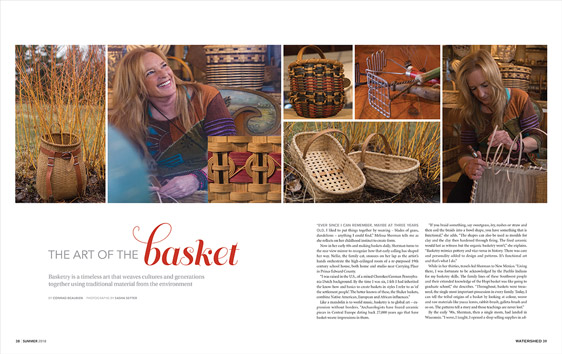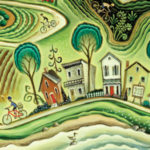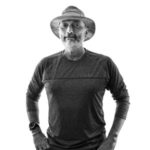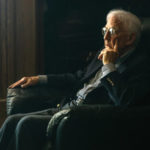
Basketry is a timeless art that weaves cultures and generations together using traditional material from the environment.
“EVER SINCE I CAN REMEMBER, MAYBE AT THREE YEARS OLD, I liked to put things together by weaving – blades of grass, dandelions – anything I could find,” Melissa Sherman tells me as she reflects on her childhood instinct to create form.
Now in her early 60s and making baskets daily, Sherman turns to the rear view mirror to recognize how that early calling has shaped her way. Nellie, the family cat, snoozes on her lap as the artist’s hands orchestrate the high-ceilinged room of a re-purposed 19th century school house, both home and studio near Carrying Place in Prince Edward County.
“I was raised in the U.S., of a mixed Cherokee/German Pennsylvania Dutch background. By the time I was six, I felt I had inherited the know-how and basics to create baskets in styles I refer to as ‘of the settlement people’. The better known of these, the Shaker baskets, combine Native American, European and African influences.” Like a mandolin is to world music, basketry is to global art – expression without borders. “Archaeologists have found ceramic pieces in Central Europe dating back 27,000 years ago that have basket-weave impressions in them.
“If you braid something, say sweetgrass, ivy, rushes or straw and then coil the braids into a bowl shape, you have something that is functional,” she adds. “The shapes can also be used as moulds for clay and the clay then hardened through firing. The fired ceramic would last as witness but the organic basketry won’t,” she explains. “Basketry mimics pottery and vice-versa in history. There was care and personality added to design and patterns. It’s functional art and that’s what I do.”
While in her thirties, travels led Sherman to New Mexico. “Living there, I was fortunate to be acknowledged by the Pueblo Indians for my basketry skills. The family lines of these Southwest people and their extended knowledge of the Hopi basket was like going to graduate school,” she describes. “Throughout, baskets were treasured, the single most important possession in every family. Today, I can tell the tribal origins of a basket by looking at colour, weave and raw materials like yucca leaves, rabbit-brush, galleta-brush and so on. The patterns tell a story and those teachings are never lost.”
By the early ’90s, Sherman, then a single mom, had landed in Wisconsin. “I wove, I taught, I opened a shop selling supplies in addition to my own work, all of it while raising three kids.” When she looks back on those times, she recognizes basketry was not only her passion, but a means of supporting her family.
Sherman’s agile hands gesture the telling of how, while living in Wisconsin, a key revelation came to light. “One day, a woman came in and asked me if I was related to the Angstadt family of pattern makers,” Sherman mentions. “Sure, I carried the family connection in my name but didn’t know of any pattern makers,” she smiles. “The woman later returned and handed me a manuscript for a book of weaving patterns dating to the 1800s. It was written by Jacob Angstadt, a way-back ancestor of mine from Pennsylvania,” she furthers. “Turns out that side of my family was noted for creating the ‘summer/ winter’ pattern that’s still popular with textile weavers today.
“The publication told how there were 17 generations of weavers in my family tree. I was stunned. While the patterns were for woven things like tablecloths or bedspreads, I began to create basket patterns of my own. Unbeknownst to me, I truly had the genes of a crowd of weavers!”
The telling of Melissa Sherman’s story wouldn’t be complete without mention of her established role in the world of bluegrass music, for it was music that led the artist to Prince Edward County. Her musical roots reach back to her childhood – she can still picture her mom, a professional ballerina, tap dancing in the kitchen every morning as her family was having breakfast.
“Basketry is a medium that began to connect to my music in recent years. I’m a ballad writer and the basket is also about story, like the Pueblos,” she offers. “My main instrument is the acoustic upright bass, the ‘doghouse bass’ in the slang of bluegrass music because of its size.”
Sherman’s music and mood affect the outcome of her basket creations. “I will weave a basket one day and on the next, using the identical type and amounts of material and working the very same basket, it can turn out larger or smaller according to the tension in the weave. It’s like a song, a mood chart.
“I have worked and experimented in every natural fibre and colour imaginable,” says Sherman. “Pine needles, willow, black ash, maple and so on,” she adds. “I have a crop of willow in my backyard. It’s fast growing, replenishable and biodegradable. A forest can be cultivated to grow similar crops instead of being cleared.”
Dogwood, privet, larch, blackthorn and chestnut branches; broom, jasmine and periwinkle twigs; elm and linden shoots, ivy, clematis, honeysuckle and rose vines, rushes, weeds and straw grow in every part of the world and are woven into cultures in every part of the world. Theory has it that perhaps the first agriculture production was not food crops but basketry crops, cultivated to make gear like fish traps and weirs.
Basketry is actually one of humankind’s most important and diverse technologies: homes, boats, tools, carryalls, hats, chariots, mats and fences made of woven natural fibre have supported civilization through the millennia. Maybe not so many chariots nowadays, but hundreds of examples remain part of daily use worldwide. Think of a large, tightly-woven basket carrying pilot and passengers ten storeys above the open landscape in a hot air balloon. Despite having every option of modern material, the woven rattan people-carrier, padded at the edges with leather, remains first choice for hot air balloonists for its sturdiness, cushion upon landing and resilience to wear.
Melissa Sherman is carrying on the traditional skills of her ancestors but at the same time, she is shaping her own legacy, one basket at a time. Both her loves – music and basket making – sustain her and continue to drive her purpose. “I hope to open up time to do experimental weaving in large scale to really bring it down home.”
Story by:
Conrad Beaubien
Photography by:
Sasha Sefter


